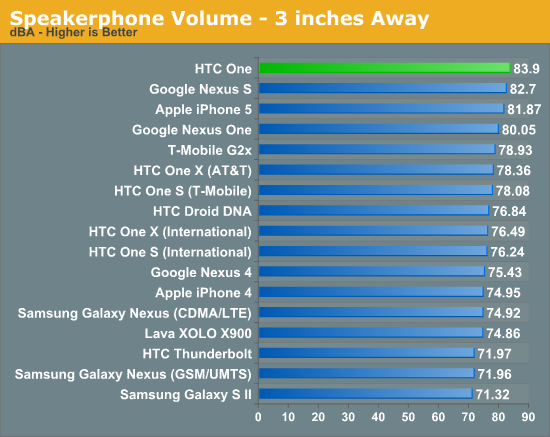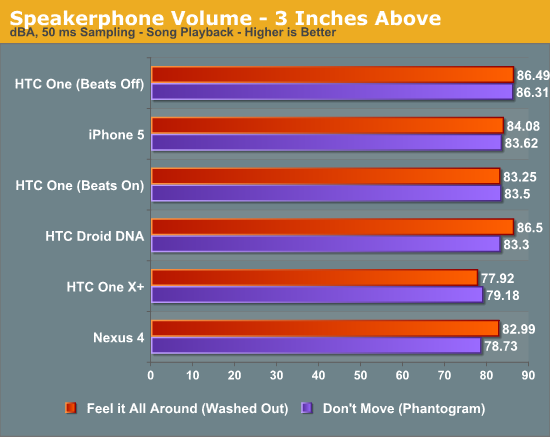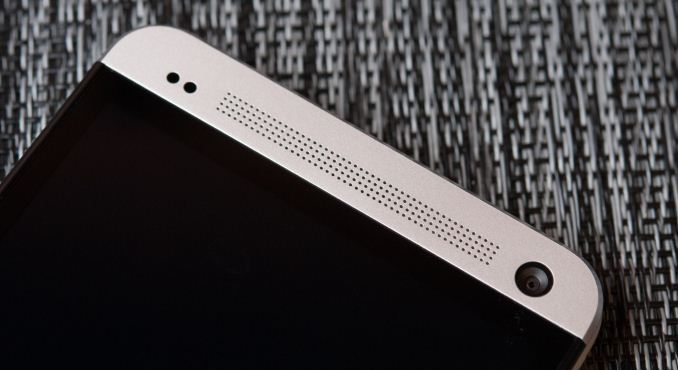The HTC One Review
by Brian Klug on April 5, 2013 8:50 PM EST- Posted in
- Smartphones
- HTC
- Android
- Mobile
- HTC One
- Snapdragon 600
BoomSound Speakerphone and Call Quality
With the One, HTC continues its partnership with Beats Electronics for use of the Beats Audio branding and experience thanks to its stake in the company. While the previous version of Beats amounted to basically dynamic range compression running either on the Qualcomm DSP inside Snapdragon or somewhere else on the AP Tegra 3, Beats as of late has started to translate to substantially different hardware with real improvements. The One includes a number of audio features that make it stand out from the norm, starting with an obvious industrial design feature — dual front facing speakers.
I don’t think it’s an exaggeration to state that the dual front facing speakers on the One are phenomenal. Without even making any audio measurements, it was obvious immediately that they represent a substantial audible improvement over just about every other smartphone purely because they’re stereo, and they’re good speakers at the same time. I’m reminded of the first time I heard stereo audio while playing YouTube videos on a Samsung Galaxy Tab 10.1 after being an iPad user for a while, I was in disbelief that adding stereo made. With the One I am equally shocked at just how much of a difference stereo makes on a smartphone, even given the small separation distance that the size of the One provides. Consuming media on the device or showing a video to a friend is so much better with stereo sound, and it’s hard to characterize just how noticeable the difference is since you need to be in front of it to experience it.
A close to second to the fact that there are two speakers is just how much of a difference putting those speakers on the front makes. After using the One I can’t help but think - why the heck are speakers on other smartphones on the backside? A few use cases stuck out at me as being just head and shoulders above with the front facing speakers. First, in a car, using Google Navigation on the device is much improved over those with the speaker on the back. I usually use a mount or lay phones on my leg when using Google Navigation, where rear speakers either need to reflect off the windshield to be heard or get covered up by my leg. It just makes sense having them on the front in that scenario. Obviously watching YouTube videos or showing friends highlights reels is a huge use case, to say nothing of using the One to play music in a hotel room when traveling. Even conference calls make more sense, since the last thing you want to do to a phone is put it display-down on a table and let it get all scratched up.
What’s interesting is that the One manages to include both the earpiece and primary speaker in the top module, and microphone plus second speaker in the bottom. Basically the top speaker has a mode for earpiece function and another mode for speaker function. Both speakers are relatively gigantic for a smartphone, and fit inside a 16 mm x 9 mm x 3 mm outline.
I ran the HTC One through our normal speakerphone tests and a few more. The speakerphone test consists of a call placed to a local test number that always plays the same recorded message with a sound level data logger 3-inches above the front of the display. Since the first device I’ve tested this way, they’ve always been placed display-up, which obviously helps the HTC One. In addition speakerphone volume is cranked to maximum on the devices.

The HTC One tops the charts in the speakerphone call test, not by a huge margin, but tops them nonetheless. There’s no distortion or crackling from saturation on the One during the speakerphone call.
In addition I decided to run another new test which consists of two songs played back with the same USB datalogger setup. I played the entire song while capturing data and took the average. There’s an audible difference between the One and all the other phones I tested, and the data backs it up.

I tested the One with Beats enabled and disabled, and interestingly enough Beats disabled results in louder sound measurements. I’m told that turning Beats on changes some equalizer settings that result in lower overall dBA weighted measurements (the weighting we’ve always used). Either way, the result is that the HTC One is 2.5 dB louder than the iPhone 5, and listening to the device, it’s obvious that the One has wider frequency response. In addition stereo opens up the soundstage in a way that makes listening much more enjoyable than you’d expect from a smartphone.
The One joins a number of other devices shipping this year which contain active components designed to increase speaker volume and still protect it from damage. In the case of the HTC One, based on my digging that is a pair (one for each speaker) of NXP TFA9887 ICs. NXP describes the TFA9887 as an audio system with adaptive sound maximizer and speaker protection. This system optimizes speaker loudness while making sure speaker membrane displacement and temperature do not exceed safe limits. I saw a similar system inside the Droid DNA / Butterfly. The audio codec (Qualcomm calls it a sound SoC) itself used inside the HTC One is the familiar Qualcomm WCD9310 which manages pretty much all the audio IOs over SLIMbus.
Not satisfied with just saying that the One is measurably louder than some other phones, I consulted Chris Heinonen (our displays editor and sound guru) to measure the speaker output using a calibrated microphone and Room EQ software. I measured against the iPhone 5 just since it’s another phone with significant pedigree for having good speakerphone output.
I measured THD+N (total harmonic distortion plus noise) at two different points, at 1 kHz and 10 kHz using the calibrated microphone at the same sound pressure level on the HTC One with Beats on and off and the iPhone 5.
At 1 kHz, the HTC One has a THD+N of just above 6.1 percent with Beats on, and around 6.7 percent with Beats off, at 100 dBA at 1 kHz. Compare to the iPhone 5, which gets around 9.6 percent of THD+N for the same loudness. We can also see that the harmonics are also taller on the iPhone 5 than the HTC One, which means they’re more audible. The tradeoff is that the iPhone 5 does have more dynamic range at other points with less noise, for example between 100 and 700 Hz around 20 dBA of noise, whereas the HTC One is around 30 dBA. I’d expect this is outweighed by the louder harmonics though at 1 kHz.
At 10 kHz the iPhone 5 does better, with THD+N of 2.75 percent, while the HTC One is up at around 5.8 or 6 percent depending on Beats. We can also see that the the 10 kHz spike is much pointier meaning more dynamic range on the iPhone. What’s interesting however is the much taller 2nd harmonic on the iPhone 5. I should also note that the iPhone 5 was cranked to almost maximum volume to get around 95 dBA at 10 kHz while the HTC One was just above halfway — it can go considerably louder.
Lastly, the only issue I’ve found with the HTC One is that left channel seems to be always mapped to the top speaker, and right channel to the bottom speaker. This means that left channel is indeed left when rotated −90 degrees (90 degrees counter clockwise), but that the channels are swapped when rotated 90 degrees (90 degrees clockwise).
The speakers on the One are a critical part of the overall multimedia experience. Showing highlights reels to friends wouldn’t be the same without stereo or the loudness that the One’s system offers. Likewise I’ve been using the device while traveling as a standalone speaker extensively and am impressed with its ability to fill a hotel room on its own with tunes. Putting the speakers on the front just makes a ton of sense, it’s something I don’t see other handset makers doing.
Call test
The One uses the top speaker as both earpiece and speakerphone, which means it needs to carefully switch between the two. I haven’t had any issues with the earpiece going too loud yet, but an interesting side effect is that the One can go quite loud on phone calls. HTC has chosen to market that the One can increase the volume of calls based on the presence of background noise under the Sense Voice branding. Other phones have been doing this for some time now, I’m not sure if HTC has made it more pronounced with the One than other handsets however.
The One also has a secondary microphone for rejecting noise on the backside. It’s a tiny notch in the white plastic on the right side of the phone. The HTC One is using Qualcomm’s Fluence which comes with the APQ8064T platform, as verified by poking around inside the ROM.
persist.audio.fluence.mode=endfire
I recorded a call with the HTC One in front of some speakers to test noise rejection the same way I have numerous other phones, by playing a distractor babble track and placing a call to another smartphone where I record the call. This tests the noise rejection on the handset placing the call, which is what I’m most interested in. Volume of the distractor track is ramped up to around 92 dBA and then decreased.
In practice the HTC One noise rejection is adequate but nothing particularly special. I’m spoiled by the Audience solution, even if there’s a power disadvantage from going with their older solutions which were built on a 65nm process, though the newer hardware has considerable power gains. Qualcomm’s fluence gets the job done in most circumstances however.
The HTC One is also AMR-WB (Adaptive Multi Rate - Wideband) enabled, as expected with basically all the new flagship phones. If you’re lucky enough to be on a wireless operator that enables this, and are terminating a mobile call to another subscriber on the same operator with AMR-WB, then you’ll enjoy an awesome higher bitrate, higher bandwidth (8 kHz with 16 kHz sampling rate) and better sounding circuit switched voice call. The calls I placed with the HTC One on T-Mobile and AT&T sounded good, but I’m still hunting for AMR-WB. Because the top speaker doubles as the earpiece, it sounds crisp and doesn’t saturate. I’d describe the sound as one of the most native I’ve heard, but then again I don’t do much voice calling.
As an aside I still wish AT&T would deploy AMR-WB so I could use it on my primary line, instead AT&T continues to run AMR-NB, and only recently has deployed full bitrate AMR-NB (sometime in 2013 continues to be the vague AT&T deadline for AMR-WB). It also goes without saying that the T-Mobile USA version will include AMR-WB support, and the Sprint version will include EVRC-NW, the CDMA2000 HD voice equivalent.











